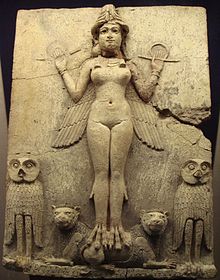Rod-and-ring symbol
It is held by a god or goddess and in most cases is being offered to a king who is standing, often making a sacrifice, or otherwise showing respect.
The symbol dates from the Third Dynasty of Ur to the Neo-Assyrian period, and is commonly explained as a coil of measuring string and a yardstick.
The symbol is also illustrated in the "Investiture Scene" painted at the palace of Mari.
[4] The most elaborate depiction is found on the Ur-Nammu-stela, where the winding of the cords has been detailed by the sculptor.
"[6] In tablet IV of the Enuma Elish, the rod and ring symbol is referenced as:

